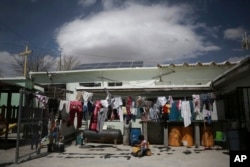For more than a year, the Biden administration kept in place at the U.S. southern border a Trump-era policy known as Title 42, which allowed the United States to quickly expel migrants to their country of origin or Mexican border towns.
On April 1, the administration announced the policy would end on May 23, giving U.S. officials time to prepare for what they expect to be an increase in migrant arrivals at the U.S.-Mexico border.
Some Democrats celebrated the end of Title 42, but Republicans want to keep the policy in place.
Here's what you need to know.
What is Title 42?
Title 42 comes from a 1944 public health law to prevent the spread of communicable disease. It was implemented in March 2020 by the U.S. Centers for Disease Control and Prevention. The CDC order empowered border enforcement agencies to remove migrants crossing into the United States, including those hoping to apply for asylum, which is their right under U.S. law and international treaty.
How did expulsions work?
Once Title 42 was implemented at the U.S.-Mexico border, immigrants encountered by border patrol officers were sent back to Mexico within hours or back to their country of origin within days — without any immigration process.
Theresa Cardinal Brown, director of immigration and cross-border policy at the Bipartisan Policy Center, said under the policy, this meant "no legal consequence" to migrants who tried to cross between ports of entry.
Brown said without Title 42, "There would be a consequence that would make it harder for them to come back legally under immigration law. So, by using Title 42, there was no consequence, and therefore what we saw was many immigrants, particularly Mexicans, who had been expelled back to Mexico, simply trying again," ultimately fueling a significant increase in repeat border crossings.
What is the latest encounter data from the southern border?
According to U.S. Customs and Border Patrol (CBP) data, Title 42 has been used in most of the estimated 2 million expulsions of migrants from Brazil, Central America, Haiti, Mexico and Colombia since March 2020. Other asylum-seekers from South America also have been rapidly blocked at ports of entry under the policy.
In February, U.S. border officials registered 164,973 migrant encounters. Of those, 91,513 were expelled. The rest could have been detained, allowed to seek asylum, paroled or other possibilities.
In February 2021, CBP recorded 101,099 migrant encounters, and in February 2020, just before Title 42, encounters were 36,687. In 2019, the last year before the pandemic, the February encounters were 76,545.
Brown said the rate of repeated crossing attempts is estimated to be 30% higher in the Title 42 era.
"Before that, recidivism rates were relatively low, below 10%," she said.
What about those who were not expelled?
The migrants who made it into the U.S. under asylum claims — mostly unaccompanied children and migrant families with children — received a notice to appear in immigration court. With the current immigration court backlog of 1.7 million cases, the asylum process can take years.
What could happen at the border after May 23?
Luis Miranda, a CBP spokesperson, told VOA that officials will "simply go back to processing any encounters across the border the way we always have under Title 8, which is the immigration authority that has always been in place throughout the history of U.S. Customs and Border Protection."
Miranda said the U.S. government is expecting arrivals to increase at the southern border but added that those unable to establish a legal basis to remain in the United States will be removed.
"We've been planning for that. … And to process any encounters effectively, humanely. But ultimately, if someone is trying to come in without legal authorization and doesn't have the legal basis to stay, they will be placed in removal proceedings," he said.
How does the law treat migrants?
Those arriving at the border without documents or trying to enter between ports of entry can be removed without their case being decided by an immigration court.
However, if a migrant wants to claim asylum, they are interviewed by an asylum officer before a removal or deportation.
Federal law allows people from other countries to seek asylum in the United States if they fear persecution at home. They must be present in the U.S. and prove a fear of persecution on one of five grounds: race, religion, nationality, political opinion or membership in a particular social class (the most vague of the five categories; it can include grounds such as sexuality or caste).
If a migrant passes what's called a credible fear screening by the asylum officer, then their case is referred to immigration court, where the migrant can apply for asylum as a defense against being deported. If they don't pass the fear screening or are denied in immigration court, the applicant will be removed. If they try to come back without documents, the penalties can be higher, such as being prosecuted under criminal law and denied the ability to apply for any legal immigration visa in the future.
Will Title 42 come back?
On April 3, the Republican-led states of Missouri, Louisiana and Arizona filed a lawsuit arguing the administration did not correctly justify its decision to end Title 42.
And, Brown said, it is "very possible" that a judge could "order the administration to continue Title 42 for some period of time while that litigation plays out."
In the meantime, Republicans blocked a Democratic attempt to initiate a Senate debate on a $10 billion COVID-19 compromise. They are demanding a vote targeting the Biden administration's decision to end Title 42.
VOA's Jorge Agobian contributed to this report.














